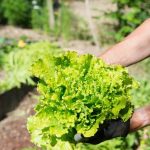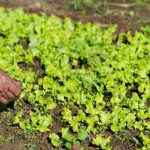Have you ever wondered why gardeners cover their vegetable gardens? In this blog post, we will explore the importance of using covers for your vegetable gardens and the numerous benefits they provide. From protecting your plants from harsh weather to extending the growing season, covering your vegetable gardens is a valuable practice that can result in a thriving and successful harvest.
Covering your vegetable gardens is not just about adding a decorative touch to your outdoor space – it serves as a crucial step in ensuring the health and vitality of your plants. As we delve into the various reasons for covering vegetable gardens, you will discover how this simple practice can make a significant difference in the overall well-being of your garden.
Throughout this blog post, we will discuss different types of garden covers, protection from pests and harsh weather, temperature regulation, weeding and maintenance benefits, extending the growing season, and eco-friendly practices. By understanding the importance of covering your vegetable gardens, you can elevate your gardening experience and achieve remarkable results.
Types of Garden Covers
There are several types of garden covers that can be used to protect vegetable gardens and promote optimal growth. One of the most common types is row covers, which are large sheets of lightweight fabric that are placed directly over the plants. Row covers provide protection from pests and harsh weather while still allowing light, air, and moisture to reach the plants.
Another type of cover is cloches, which are small, transparent domes that are placed over individual plants. Cloches help create a mini greenhouse effect by trapping heat and protecting delicate seedlings.
Garden fabric is another popular option for covering vegetable gardens. This permeable material is placed directly over the soil to prevent weed growth and retain moisture, while still allowing for proper air and water circulation. Additionally, garden fabric can provide some protection from frost and extreme temperatures, making it a versatile choice for gardeners.
Each type of garden cover has its own unique advantages and can be used in different situations depending on the specific needs of the vegetable garden. By understanding the differences between row covers, cloches, and garden fabric, gardeners can make informed decisions on how to best protect their plants and promote healthy growth.
Overall, choosing the right type of garden cover for your vegetable garden is essential for ensuring its success. Whether it’s row covers, cloches or garden fabric, each type provides valuable protection from pests, harsh weather conditions, temperature regulation and weeding maintenance that can contribute to a thriving harvest while also promoting eco-friendly gardening practices.
Protection From Pests
Protecting your vegetable garden from pests is essential for ensuring a bountiful harvest. Garden covers are an effective way to keep insects and small animals at bay, ultimately safeguarding your plants from damage. By using different types of covers, you can create a protective barrier that deters unwanted visitors and preserves the health of your garden.
Preventing Insect Infestations
Insects such as aphids, caterpillars, and beetles can wreak havoc on vegetable gardens, causing damage to leaves, stems, and fruit. Utilizing row covers or garden fabric can effectively shield your plants from these pests by physically blocking their access to the crops. These covers act as a protective shield without the need for chemical pesticides, promoting natural pest control methods.
Deterrent for Small Animals
In addition to insects, small animals like rabbits, squirrels, and birds can pose a threat to vegetable gardens by feeding on tender young shoots or ripe produce. Cloches are a great option for protecting individual plants from these creatures. These dome-shaped covers serve as a physical barrier against animal intrusion while still allowing sunlight and moisture to reach the plants.
Examples of Common Pests
Common garden pests that can be effectively deterred by covers include cabbage worms that feed on brassicas, flea beetles that attack leafy greens, and deer that may browse on various crops. By understanding the specific threats posed by these pests and implementing appropriate covers, you can significantly reduce the risk of damage to your vegetable garden.
By investing in suitable garden covers and taking proactive measures to protect your vegetables from pests through physical barriers rather than chemical interventions, you can ensure the health and productivity of your garden while maintaining eco-friendly practices.
Protection From Harsh Weather
Protecting your vegetable gardens from harsh weather conditions is vital to ensure the health and survival of your plants. Harsh weather, such as frost, hail, and heavy rain, can easily damage delicate vegetables and hinder their growth. However, with the right garden covers, you can provide a layer of protection that shields your plants from these adverse conditions.
Garden Covers for Weather Protection
There are several types of garden covers that are specifically designed to protect against harsh weather. Row covers, for example, are lightweight fabric covers that can be easily draped over plants to shield them from frost and cold temperatures. Cloches, on the other hand, are bell-shaped transparent covers that create a mini greenhouse effect for individual plants. Additionally, garden fabric can also be used to cover entire beds or rows for protection against heavy rain and hail.
Impact of Weather on Vegetable Gardens
Extreme weather conditions can have a significant impact on the health and yield of vegetable gardens. Frost, for instance, can lead to frost damage in tender plants, causing them to wilt or die.
Hail can cause physical damage to the leaves and stems of vegetables, while heavy rain can lead to waterlogged soil and root rot. By using garden covers to protect your vegetable gardens from these weather phenomena, you can effectively mitigate potential damage and ensure the well-being of your plants.
Benefits of Using Garden Covers for Weather Protection
By utilizing garden covers to shield your vegetable gardens from harsh weather conditions, you contribute to creating a stable environment that promotes healthy plant growth. These covers act as a barrier against external elements, allowing your plants to thrive without being negatively impacted by inclement weather. Ultimately, the use of garden covers for weather protection not only safeguards your vegetable gardens but also supports their successful development throughout the growing season.
Temperature Regulation
Covering vegetable gardens can significantly impact the temperature regulation of the garden environment. By using specialized covers such as row covers, cloches, or garden fabric, gardeners can create a microclimate that is conducive to optimal plant growth. These covers act as insulators, trapping heat during cooler temperatures and providing shade during warmer weather. This helps in maintaining a stable temperature for the plants, which can result in healthier and more productive crops.
Studies have shown that temperature plays a crucial role in plant growth and development. Fluctuations in temperature can affect the germination of seeds, flowering, and fruit formation of vegetables. By utilizing garden covers to regulate temperature, gardeners can ensure that their plants are not exposed to extreme conditions that could stunt their growth or lead to poor yields.
In addition to promoting better growth conditions for plants, regulating temperature through garden covers also provides protection against unexpected weather changes. Sudden cold snaps or unseasonably warm days can have detrimental effects on vegetable gardens but with proper coverage, these fluctuations can be mitigated. This ultimately leads to a more predictable growing environment and a better overall harvest.
| Types of Garden Covers | Benefits |
|---|---|
| Row Covers | Insulates and protects from frost |
| Cloches | Create mini greenhouse effect for warmth |
| Garden Fabric | Maintains stable temperatures and protects from pests |
Weeding and Maintenance
Covering your vegetable gardens not only provides protection from pests and harsh weather but also plays a role in reducing the need for frequent weeding and maintenance. Here are some ways garden covers can help in this aspect:
- Weed Suppression: Garden covers act as a barrier, preventing weed seeds from getting the sunlight and air they need to germinate and grow. This helps reduce the growth of weeds in your vegetable garden, saving you time and effort spent on constant weeding.
- Moisture Retention: Certain types of garden covers can help retain moisture in the soil, reducing the frequency of watering and minimizing the need for constant maintenance. This ensures that your plants have a consistent water supply, promoting healthier growth while requiring less upkeep.
- Protection from Soil Erosion: Covers can help prevent soil erosion caused by heavy rain or strong winds. By keeping the soil in place, you’ll spend less time fixing and tending to eroded areas in your garden.
By implementing these strategies, covering your vegetable garden can create a more manageable and low-maintenance gardening environment. With reduced weed growth, moisture retention, and protection against soil erosion, using garden covers can lead to easier maintenance tasks and a healthier overall garden ecosystem.
Additionally, adopting these practices aligns with eco-friendly principles by promoting sustainable gardening methods that reduce the reliance on chemical herbicides while conserving water resources. Overall, incorporating garden covers into your vegetable gardening routine not only simplifies maintenance but also contributes to an environmentally conscious approach to cultivating your harvest.
Extending the Growing Season
Gardening is a rewarding and fulfilling activity, and one way to maximize its benefits is by extending the growing season of your vegetable gardens. By doing so, you can continue enjoying fresh produce well beyond the typical harvest period. There are several methods to achieve this goal, such as using garden covers. Here are some ways in which covering your vegetable gardens can help extend the growing season:
- Protection from early frosts: Garden covers provide a barrier against frost, allowing your plants to thrive despite the drop in temperature. This is particularly beneficial for cold-sensitive vegetables such as tomatoes, peppers, and eggplants.
- Shielding from late-season cold snaps: As the end of the growing season approaches, unexpected cold snaps can pose a threat to your crops. However, with the use of garden covers, you can safeguard your plants from sudden drops in temperature, giving them more time to mature and produce.
- Creating a warmer microclimate: By trapping heat and regulating temperature, garden covers can create a favorable environment for plant growth. This is especially useful for cool-weather crops like lettuce, spinach, and kale, allowing you to cultivate these vegetables even as temperatures begin to decline.
Extending the growing season through the use of garden covers not only provides an abundance of fresh produce for longer periods but also allows you to make the most out of your gardening efforts.
Whether you are an avid gardener or someone who simply enjoys cultivating a few plants for personal consumption, utilizing garden covers can significantly impact the success and productivity of your vegetable gardens. So if extended harvests and thriving crops sound appealing to you, consider incorporating garden covers into your gardening practices for an optimal growing experience.
Eco-Friendly Practices
Covering your vegetable gardens with the right materials and techniques can not only benefit your plants but also contribute to eco-friendly gardening practices. By using garden covers, you can reduce the need for chemical pesticides and promote sustainable gardening. This section will explore the environmental impact of covering vegetable gardens and how it aligns with eco-conscious principles.
One of the main eco-friendly benefits of using garden covers is the reduction in the use of chemical pesticides. By creating a physical barrier between your plants and pests, covers can help minimize pest damage without relying on harmful chemicals. This not only protects your garden from potential contamination but also supports a healthier ecosystem by preserving beneficial insects and wildlife.
In addition to reducing the need for pesticides, covering vegetable gardens promotes sustainable gardening practices by conserving water and other resources. Garden covers can help retain moisture in the soil, minimize evaporation, and protect plants from extreme weather conditions, ultimately reducing the overall water consumption in your garden. Furthermore, by extending the growing season and protecting plants from harsh weather, you can maximize the yield from your garden without resorting to resource-intensive methods.
| Benefits | Explanation |
|---|---|
| Reduction in chemical pesticide use | Garden covers act as a physical barrier against pests, eliminating the need for harmful pesticides. |
| Conservation of water and resources | Garden covers help retain moisture in the soil and protect plants from extreme weather, reducing overall water consumption. |
Conclusion
In conclusion, covering your vegetable gardens is an essential practice that can have a significant impact on the health and productivity of your plants. Whether it’s protecting them from pests, harsh weather, or temperature fluctuations, garden covers provide a layer of defense that can make a remarkable difference in the overall success of your garden. By understanding the different types of garden covers available and their benefits, you can effectively create a thriving environment for your vegetables to flourish.
Throughout this blog post, we have discussed the various advantages of using garden covers, ranging from pest protection to extending the growing season. It is evident that implementing this simple practice can lead to a more sustainable and eco-friendly approach to gardening by minimizing the need for chemical pesticides and promoting healthier plant growth.
By considering the use of covers for your vegetable gardens, you are not only investing in the future success of your harvest but also contributing to environmentally responsible gardening practices.
Therefore, we encourage our readers to give due consideration to incorporating garden covers into their vegetable gardening routine. With a better understanding of how garden covers can positively impact plant growth and overall garden maintenance, it’s time to take advantage of these benefits and see firsthand how covering your vegetable gardens can lead to a successful and thriving harvest.
Frequently Asked Questions
Should You Cover Your Vegetable Garden?
Covering your vegetable garden can be beneficial in protecting your plants from extreme weather conditions, pests, and diseases. It can also help to provide a more controlled environment for your plants to thrive, especially during the early growing stages.
At What Temperature Should I Cover My Vegetable Garden?
The temperature at which you should cover your vegetable garden will depend on the specific needs of the plants you are growing. Generally, covering should be considered when temperatures drop below 50°F (10°C) for most vegetables. However, more sensitive plants may require covering at even higher temperatures to ensure their protection.
Which Vegetables Need to Be Covered?
Certain vegetables that are more sensitive to colder temperatures may need to be covered in order to protect them from frost damage. Some examples of these vegetables include tomatoes, peppers, eggplants, and cucumbers.
On the other hand, cold-hardy vegetables such as kale, spinach, and carrots may not need covering unless temperatures become extremely low. It’s important to research the specific needs of each vegetable in your garden to determine if they require covering or not.

If you’re looking to get into vegetable gardening, or are just looking for some tips on how to make your current garden better, then you’ve come to the right place! My name is Ethel and I have been gardening for years. In this blog, I’m going to share with you some of my best tips on how to create a successful vegetable garden.





